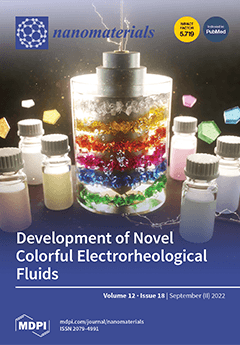MAX phases are the parent materials used for the formation of MXenes, and are generally obtained by etching using the highly corrosive acid HF. To develop a more environmentally friendly approach for the synthesis of MXenes, in this work, titanium aluminum carbide MAX
[...] Read more.
MAX phases are the parent materials used for the formation of MXenes, and are generally obtained by etching using the highly corrosive acid HF. To develop a more environmentally friendly approach for the synthesis of MXenes, in this work, titanium aluminum carbide MAX phase (Ti
2AlC) was fabricated and etched using NaOH. Further, magnetic properties were induced during the etching process in a single-step etching process that led to the formation of a magnetic composite. By carefully controlling etching conditions such as etching agent concentration and time, different structures could be produced (denoted as
M.Ti2CTx). Magnetic nanostructures with unique physico-chemical characteristics, including a large number of binding sites, were utilized to adsorb radionuclide Sr
2+ and Cs
+ cations from different matrices, including deionized, tap, and seawater. The produced adsorbents were analyzed using X-ray diffraction (XRD), scanning electron microscopy (SEM), X-ray energy dispersive spectroscopy (EDS), and X-ray photoelectron spectroscopy (XPS). The synthesized materials were found to be very stable in the aqueous phase, compared with corrosive acid-etched MXenes, acquiring a distinctive structure with oxygen-containing functional moieties. Sr
2+ and Cs
+ removal efficiencies of
M.Ti2CTx were assessed via conventional batch adsorption experiments.
M.Ti2CTx-AIII showed the highest adsorption performance among other
M.Ti2CTx phases, with maximum adsorption capacities of 376.05 and 142.88 mg/g for Sr
2+ and Cs
+, respectively, which are among the highest adsorption capacities reported for comparable adsorbents such as graphene oxide and MXenes. Moreover, in seawater, the removal efficiencies for Sr
2+ and Cs
+ were greater than 93% and 31%, respectively. Analysis of the removal mechanism validates the electrostatic interactions between
M.Ti2C-AIII and radionuclides.
Full article






